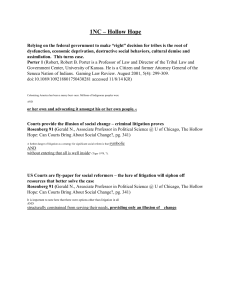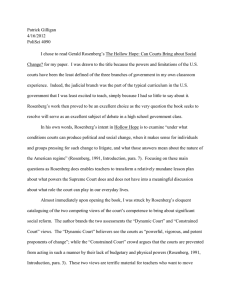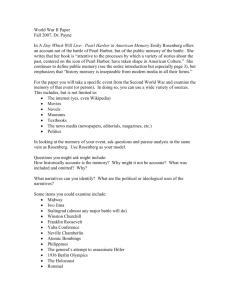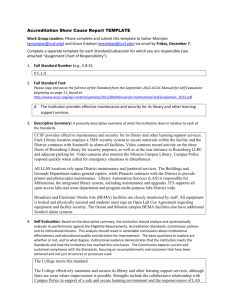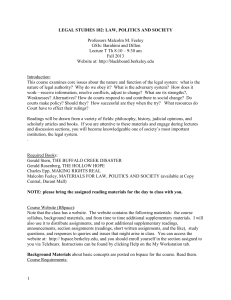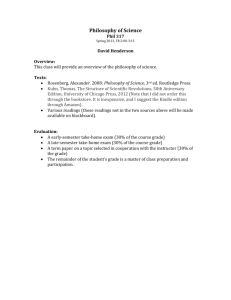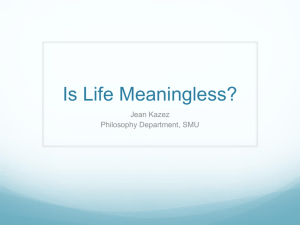THE HOLLOW HOPE: CAN COURTS BRING ABOUT SOCIAL
advertisement
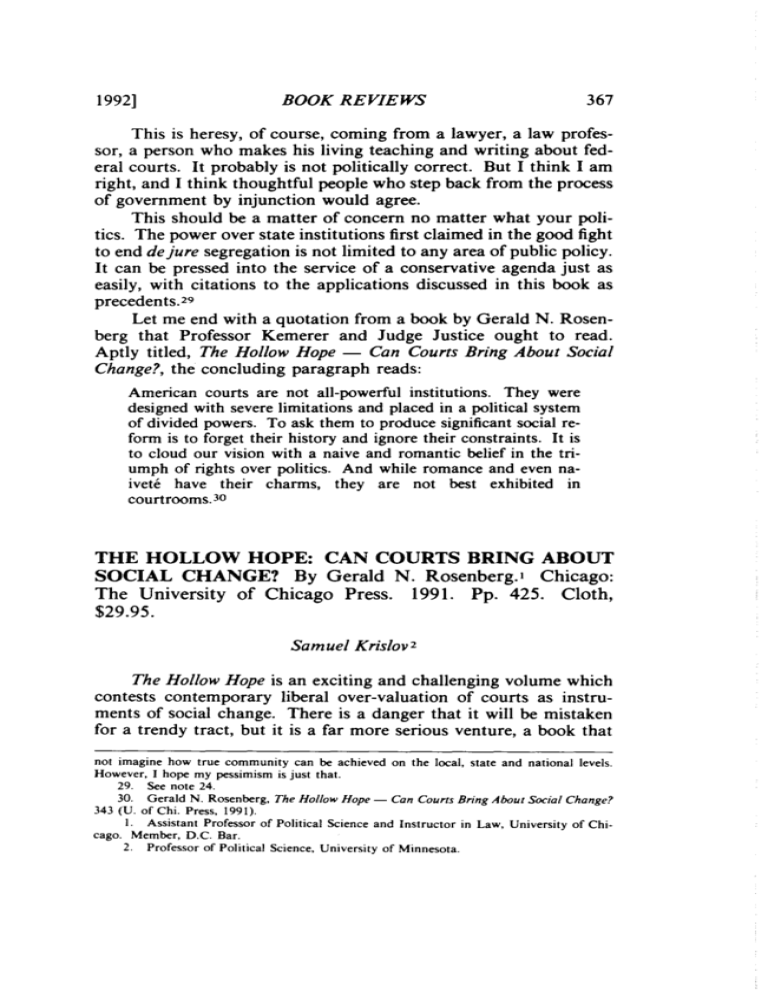
1992] BOOK REVIEWS 367 This is heresy, of course, coming from a lawyer, a law professor, a person who makes his living teaching and writing about federal courts. It probably is not politically correct. But I think I am right, and I think thoughtful people who step back from the process of government by injunction would agree. This should be a matter of concern no matter what your politics. The power over state institutions first claimed in the good fight to end de jure segregation is not limited to any area of public policy. It can be pressed into the service of a conservative agenda just as easily, with citations to the applications discussed in this book as precedents.29 Let me end with a quotation from a book by Gerald N. Rosenberg that Professor Kemerer and Judge Justice ought to read. Aptly titled, The Hollow Hope - Can Courts Bring About Social Change?, the concluding paragraph reads: American courts are not all-powerful institutions. They were designed with severe limitations and placed in a political system of divided powers. To ask them to produce significant social reform is to forget their history and ignore their constraints. It is to cloud our vision with a naive and romantic belief in the triumph of rights over politics. And while romance and even naivete have their charms, they are not best exhibited in courtrooms. 3o THE HOLLOW HOPE: CAN COURTS BRING ABOUT SOCIAL CHANGE? By Gerald N. Rosenberg. I Chicago: The University of Chicago Press. 1991. Pp. 425. Cloth, $29.95. Samuel Krislov2 The Hollow Hope is an exciting and challenging volume which contests contemporary liberal over-valuation of courts as instruments of social change. There is a danger that it will be mistaken for a trendy tract, but it is a far more serious venture, a book that not imagine how true community can be achieved on the local, state and national levels. However, I hope my pessimism is just that. 29. See note 24. 30. Gerald N. Rosenberg, The Hollow Hope- Can Courts Bring About Social Change? 343 (U. of Chi. Press, 1991). I. Assistant Professor of Political Science and Instructor in Law, University of Chicago. Member, D.C. Bar. 2. Professor of Political Science, University of Minnesota. 368 CONSTITUTIONAL COMMENTARY [Vol. 9:367 demands intellectual attention and regard. At the same time, I do have some serious reservations. Rosenberg's answers by and large seem right, but the question he asks is badly flawed, which colors the whole effort. Additionally, the marshalling of evidence is erratic and even obtuse. It is a mark of the seriousness and scope of Rosenberg's effort that it rises above these evident faults to join the list of major works on implementation. The volume is organized around two models of Supreme Court effectiveness: the "dynamic court model" and the "constrained court" model. The first is a broadly painted, command, almost King Canute notion. The "constrained court" model notes conditions for success-the need for political allies, the presence of elements of luke-warm opposition to change that can be persuaded to accept a court decision, etc. Underlying social trends should also be supportive of the court's efforts. The question Rosenberg poses is essentially which of the two models most closely approximates the Supreme Court's achievements and failures. Directly confronting the key and most impressive Supreme Court efforts at reform--desegregation, legalization of abortion, criminal justice, women's equality and reapportionment-Rosenberg concludes that given the constraints and the conditions, the constrained court view is the most accurate. Furthermore, he argues, U.S. courts can almost never be effective producers of significant social reform. Judge Posner tells us in the blurbs that it will "cause many lawyers to revise their view of the relation between law and society." Except for the extreme nature of the ultimate conclusions, even moderately informed students of the judicial process would certainly expect vindication of the "constrained court" model. Indeed, Rosenberg has some problems finding advocates of the "dynamic court;" among them he lists Joel Handler, who was one of the first scholars who helped to alert us (in the heady 1970s, not the more conservative 1990s) that Court power was not unbounded. It is not merely that the "dynamic court" is a straw-man. By concentrating on what is essentially a non-question the focus is not precise enough to permit the answer Rosenberg finally reaches. Indeed, since in at least four instances-women's rights and abortion and reapportionment and environment-he finds the "constrained view" too unsubtle to capture what was accomplished, it is not clear how the cumulative conclusion of ineffectiveness was reached. What is clear is that more sensitive answers would have been reached had the question been posed as one exploring the conditions of success. Admittedly the book would have been less bold, 1992] BOOK REVIEWS 369 less intellectually challenging, and attracted less attention had it been so structured. Wrestling with Rosenberg's evidence is half the fun of the book. He has taken on the toughest cases, and the tour de force in denying court efficacy in Brown earns some sort of medal for intellectual audacity. Chapter 4, which denies that Brown had an impact on the moral sensibility of the country, is as fascinating as it is unconvincing. Rosenberg makes this odd case by quite accurately noting the slowdown in desegregation that had occurred prior to the Powell Amendment and by reminding us of the linkage of successful integration to federal school funding. It is incontestible that this was the key to substantial compliance in the deep South. But there is no discussion of the immediate impact of Brown in desegregating not merely the border states, but also south-like enclaves in northern states like Indiana and Kansas-and most important symbolically-the District of Columbia. Nor does he acknowledge that the Court's effectiveness continued to be felt in both ongoing federal court decisions and in such decisions as Virginia's own Supreme Court rulings which de-legitimized that state's massive resistance. This reflects a basic problem with his test of "social reform." There is no measure of effectiveness advanced other than that it be nationwide and concern more than one agency; there is also implicit definition via a list of social reforms of our time. But apparently no partial successes count. In a number of instances, ostensible goals quoted in the cases are discounted. For example, Rosenberg argues that Roe implies that hospitals had a legal obligation to provide abortions; therefore, the development of abortion clinics was a symptom offailure. Perhaps the Justices intended to bind hospitals, but nothing he cites in the cases or my own reading allows me to reach his plane of understanding of their goals. The difficulty with this ali-or-nothing approach is basic, and painfully evident in the public administration literature on implementation and even in his own comments on other institutions. Courts are not less efficient or in any way distinctly different from other institutions. How often does Congress, the President, Solidarity or a Leninist cadre single-handedly effect "social reform"? In how many instances is a policy realized precisely as the progenitors envisioned it? Would not someone studying congressional impact note the need for presidential, bureaucratic, or local assistance? Would not they note many instances where institutions succeeded only because of the coming of the "least dangerous branch" to the rescue of the "powerful" President or Congress? 370 CONSTITUTIONAL COMMENTARY [Vol. 9:367 The news that courts are bounded should come as no surprise, but for those who need that message this is a strong dose. Judging by the naivete of many of the witnesses at Senate confirmation hearings, sales to that audience alone would make the book a mild bestseller. His conclusion that court actions do not mobilize support is in part built on questionable evidence. Rosenberg explains away the growth of support when time-series analysis suggests the court has had an impact, but stops whenever an analysis is negative or inconclusive. Even less justifiably, he ignores evidence he stumbles upon and uses dubious measures. Thus, he mentions the emergence of the Southern Education Reporting Service (but not its companion Race Relations Law Reporter), but it does not occur to him that such new media resources, such as the post-Roe emergence of MS, represent a better test of enhanced public attention than the totality of articles listed in the Readers' Guide or the percentage of columns in the New York Times Index devoted to the topic. Those curious and insensitive measures are used throughout the volume, but are barely justified and for the first time on page 289. He cites public opinion polls indicating no growth in support and, though noting others that come to different conclusions, does not provide sufficient data to overcome the suspicion that his data are selective. On the other hand, the proposition that a Supreme Court decision can provoke opposition is amply supported by his data. Thus he seriously advances the argument that interest groups must assess the costs and benefits of concentrating efforts in the judicial arena. He argues that in many instances litigating groups should sharply reassess their strategies and opt for political over litigation goals. Surely he is correct about this, especially in the light of the growing conservativism of the courts. He provides evidence of groups beggaring themselves through litigation, thereby handicapping political advancement of their cause. Still, he provides no evidence on relative costs of political over legal mobilization. He does not attempt to explain why legal efforts do not maximize the efforts of groups with limited resources, as they would superficially seem to do. His argument should give groups pause and lead them to recalculate costs and benefits more carefully. But those groups would be as oblivious to reality as he claims they have been in the past if they fail to factor in a probability that many political victories also must be re-fought in the legal arena.
